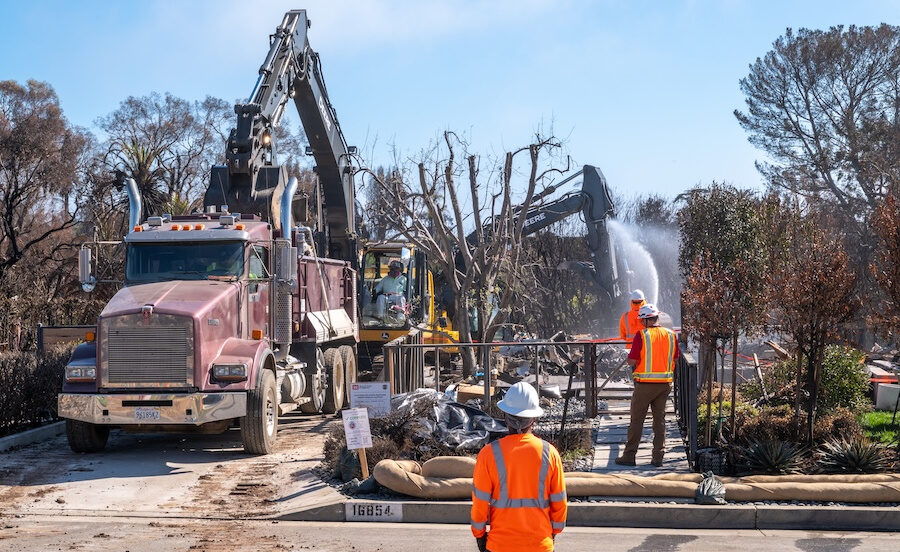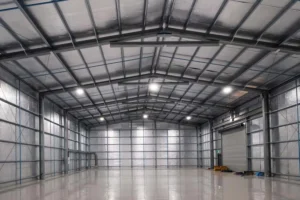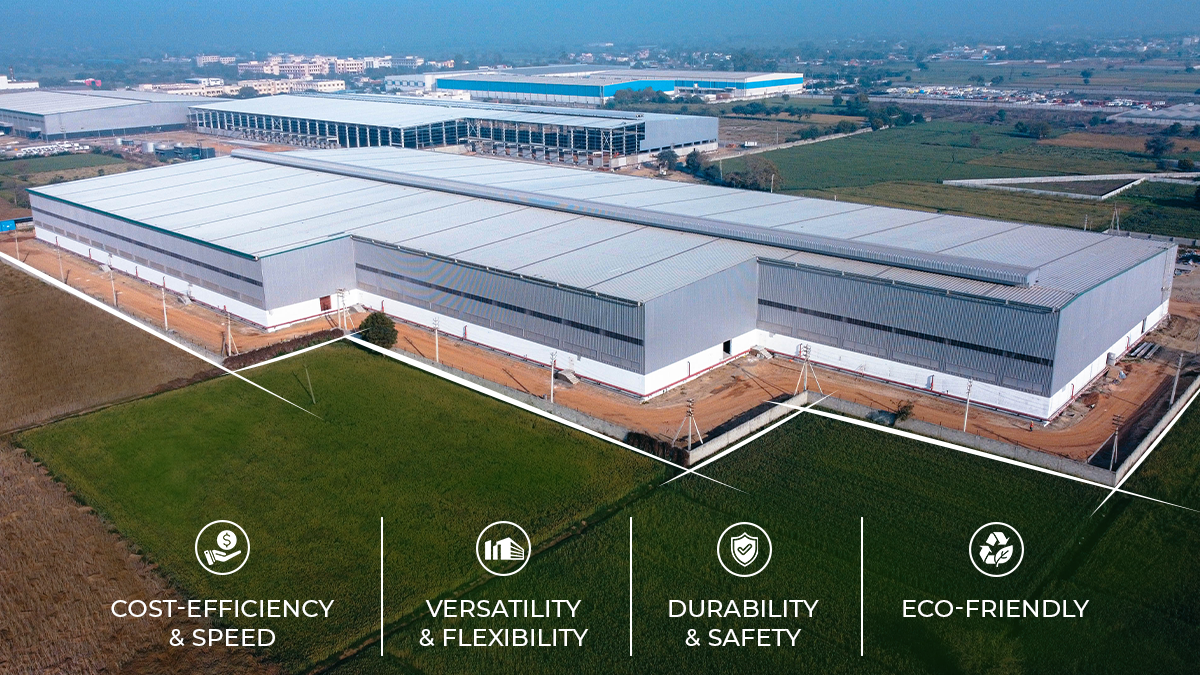
Los Angeles Wildfire Cleanup Nears Completion, Rebuilding Plans Begin
[ad_1]

Almost six months after a series of destructive wildfires swept through Los Angeles, debris removal is entering the home stretch and reconstruction efforts are on the horizon.
Since the fires hit, the U.S. Army Corps of Engineers on behalf of the Federal Emergency Management Agency (FEMA) has been steadily working to clear ash and fire debris across the Eaton and Palisades burn areas.
“The Corps has been doing this at no cost to homeowners—people could opt in or opt out to have all this debris removed from their properties,” said Ciara Barnett, assistant deputy director at Los Angeles County Public Works during ENR’s Groundbreaking Women in Construction Conference on June 9. “When they first started, they were hoping to be done by January of next year. And here in June, we have substantial completion already. So 90% of the homes have had their properties cleared of debris.”
She adds: “It is very uplifting.”
In its most recent update in June, FEMA announced that 7,214 properties had been cleared of about 2.3 million tons of debris.
During the first phase of removal, the focus lay on hazardous debris—chemicals, batteries—all of which was removed within 30 days of the fires.
“The construction industry was eager to step up and support our Southern California communities following the devastation earlier this year,” says Peter Tateishi, CEO, AGC of California. “With AGC of California member ECC under contract with the U.S. Army Corps of Engineers—and in strong partnership with numerous AGC of California members across the region—crews were mobilized quickly, and we are proud to see tangible progress being made for the families who lost their homes and communities.”
Now that sites are receiving final sign offs, property owners are gearing up to start the long process of rebuilding.
“An unprecedented natural disaster requires an unprecedented, all-hands-on-deck response—all levels of government, philanthropy, the private sector and educational institutions coming together to support the community and rebuild as quickly and safely as possible,” said Los Angeles Mayor Karen Bass in a statement.
To that end, AECOM was awarded a contract expansion on June 6 to support recovery efforts in the Pacific Palisades. In partnership with the city and Hagerty Consulting, AECOM’s expanded scope will include creating a comprehensive rebuilding master plan, an infrastructure reconstruction plan for the phased deployment of all utilities above and below ground, a logistics plan for materials management and a master traffic plan to help teams navigate the expansive construction efforts throughout the area.
“AGC of California remains committed to supporting a unified and efficient rebuild effort. We continue to work in close collaboration with local agencies, municipalities and our industry partners to ensure that recovery is strategic with industry input,” Tateishi adds.
Major work ahead
Out of the 17,000 structures destroyed, 7,600 homes were lost—including about 5,000 in Los Angeles, another 700 in Malibu, and several hundred in Pasadena, Barnett said. In total, the wildfires caused about $130 billion in damages, “making it one of the most devastating disasters in the country,” she added.
More than $3 billion in federal support has already made its way to wildfire survivors over the last five months, FEMA reported June 6, in the form of individual assistance ($136 million), rental assistance ($18 million) and federal disaster loans ($2.9 billion) for businesses, nonprofits and residents.
“We did lose 30 lives between the two fires, which makes it one of the most devastating natural disasters in California history,” Barnett added.
But given the number of rebuilds ahead, a business as usual approach won’t cut it. LAPW typically issues about 4,000 permits a year across the entire county—the agency is looking at half that volume in this one location for Eaton, hopefully within a year, she said.
“There are 88 cities and 125 unincorporated communities within LA County. One of the things we’ve been doing is trying to centralize our information, so recovery.lacounty.gov is the hub where we’re putting all our information,” Barnett said. “For now, we only have the unincorporated dashboards, but we’re working with the cities to either link to or provide their information because really we need to see the region build as a whole.”
Simplifying the way
Multiple strategies are in place to help with the rebuilding process. Homeowners are able to rebuild “like for like,” which means they can build back so long as they build substantially what they had before in about the same location—with up to an additional 10% or 200 sq ft, Barnett explained. In Eaton, about 60% of homes were built in the 1940s or earlier, so all those homes will now be rebuilt to current code.
“As we look ahead, one of the most critical factors in accelerating this rebuild will be streamlined and coordinated permitting processes. Removing unnecessary bottlenecks and establishing clear timelines will allow the construction industry to respond with the speed and scale needed,” Tateishi says. “Additionally, standardizing specifications and scopes across jurisdictions will be essential to avoiding delays, minimizing confusion, and ensuring consistent processes across the rebuild effort.”
With this in mind, LA county is modifying pathways to rebuilding and has reengineered a single application process. After applying to the county, residents first go through planning, then once building plans are in hand, all the permit departments are activated at the same time. Concurrent reviews save the applicant from having to go to multiple county departments. One-stop permit centers have also been established.
A pre-approved plan program will further facilitate getting these 7,600 properties rebuilt, especially in situations where homeowners aren’t familiar with the building process.
“Basically a designer can submit their plans, get it approved, and then we’ll file it in the catalog so the owners can reach out to these designers,” Barnett said. “If they elect to work on one of those pre-approved plans, now they only have to come in with their site-specific safety plan and their energy calculations that are specific to that property so it would be lower fees for them on the county side and faster turnarounds. And it takes out that stress of having to design a home.”
A self-certification pilot program is allowing licensed architects and engineers to attest that their plans meet code so they can bypass the building plan review. The county will then audit about 20% of those submittals to make sure they’re compliant and conduct full inspections, Barnett said.
There are different grants and different supports that the county has established for people who are under-insured,” she added. ““We’ve even got grants to hire people who lost their jobs as a result of the fire.”
While the focus has been on the residential recovery given that volume, commercial properties were also impacted. On the Eaton side, 110 commercial properties out of 6,600 were destroyed, along with 29 on the Palisade side.
Some commercial property permits have already come through and the county’s dedicated fire disaster recovery staff is working to complete initial reviews within 10 business days for both commercial and residential.
Lessons learned throughout this process will likely inform updates to future state building code. California runs on a three-year code cycle, with the next iteration due to be implemented on Jan. 1, 2026.
“The fall is when we’ll put forward any changes and I think there are a lot of people looking at fire resistant rebuilding and where it should it be required,” Barnett said. “We do have new maps that likely go into effect around the same January 1 time frame, so I think what will be explored is where should fire resistive construction be required.”
[ad_2]
Source link
Post a Comment
You must be logged in to post a comment.






